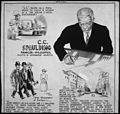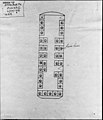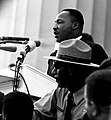The civil rights movement portal The civil rights movement was a social movement and campaign from 1954 to 1968 in the United States to abolish legalized racial segregation, discrimination, and disenfranchisement in the country. The movement had its origins in the Reconstruction era during the late 19th century and had its modern roots in the 1940s, although the movement made its largest legislative gains in the 1960s after years of direct actions and grassroots protests. The social movement's major nonviolent resistance and civil disobedience campaigns eventually secured new protections in federal law for the civil rights of all Americans. After the American Civil War and the subsequent abolition of slavery in the 1860s, the Reconstruction Amendments to the United States Constitution granted emancipation and constitutional rights of citizenship to all African Americans, most of whom had recently been enslaved. For a short period of time, African-American men voted and held political office, but as time went on Blacks were increasingly deprived of civil rights, often under the racist Jim Crow laws, and African Americans were subjected to discrimination and sustained violence by white supremacists in the South. Over the following century, various efforts were made by African Americans to secure their legal and civil rights, such as the civil rights movement (1865–1896) and the civil rights movement (1896–1954). The movement was characterized by nonviolent mass protests and civil disobedience following highly publicized events such as the lynching of Emmett Till. These included boycotts such as the Montgomery bus boycott, "sit-ins" in Greensboro and Nashville, a series of protests during the Birmingham campaign, and a march from Selma to Montgomery. At the culmination of a legal strategy pursued by African Americans, in 1954 the Supreme Court struck down the underpinnings of laws that had allowed racial segregation and discrimination to be legal in the United States as unconstitutional. The Warren Court made a series of landmark rulings against racist discrimination, including the separate but equal doctrine, such as Brown v. Board of Education (1954), Heart of Atlanta Motel, Inc. v. United States (1964), and Loving v. Virginia (1967) which banned segregation in public schools and public accommodations, and struck down all state laws banning interracial marriage. The rulings played a crucial role in bringing an end to the segregationist Jim Crow laws prevalent in the Southern states. In the 1960s, moderates in the movement worked with the United States Congress to achieve the passage of several significant pieces of federal legislation that authorized oversight and enforcement of civil rights laws. The Civil Rights Act of 1964 explicitly banned all discrimination based on race, including racial segregation in schools, businesses, and in public accommodations. The Voting Rights Act of 1965 restored and protected voting rights by authorizing federal oversight of registration and elections in areas with historic under-representation of minority voters. The Fair Housing Act of 1968 banned discrimination in the sale or rental of housing. (Full article...) Selected article -Mississippi Burning is a 1988 American crime thriller film directed by Alan Parker and written by Chris Gerolmo that is loosely based on the 1964 murder investigation of Chaney, Goodman, and Schwerner in Mississippi. It stars Gene Hackman and Willem Dafoe as two FBI agents investigating the disappearance of three civil rights workers in fictional Jessup County, Mississippi, who are met with hostility by the town's residents, local police, and the Ku Klux Klan. Gerolmo began writing the script in 1986 after researching the 1964 murders of James Chaney, Andrew Goodman and Michael Schwerner. He and producer Frederick Zollo presented it to Orion Pictures, and the studio hired Parker to direct. The writer and director had disputes over the script, and Orion allowed Parker to make uncredited rewrites. The film was shot in a number of locations in Mississippi and Alabama, with principal photography from March to May 1988. On release, Mississippi Burning was criticized by activists involved in the civil rights movement and the families of Chaney, Goodman and Schwerner for its fictionalization of events. Critical reaction was generally positive, with praise aimed towards the cinematography and the performances of Hackman, Dafoe and Frances McDormand. The film grossed $34.6 million in North America against a production budget of $15 million. It received seven Academy Award nominations, including Best Picture, and won for Best Cinematography. (Full article...)General imagesThe following are images from various civil rights movement-related articles on Wikipedia.
Related portalsWikiProjectsSelected biography -Elizabeth Ann Eckford (born October 4, 1941) is an American civil rights activist and one of the Little Rock Nine, a group of African American students who, in 1957, were the first black students ever to attend classes at the previously all-white Little Rock Central High School in Little Rock, Arkansas. The integration came as a result of the 1954 United States Supreme Court ruling Brown v. Board of Education. Eckford's public ordeal was captured by press photographers on the morning of September 4, 1957, after she was prevented from entering the school by the Arkansas National Guard. A dramatic snapshot by Will Counts of the Arkansas Democrat showed the young girl being followed and threatened by an angry white mob; this and other photos of the day's startling events were circulated around the US and the world by the press. Counts's image was the unanimous selection by the Pulitzer jury for a 1958 Pulitzer Prize, but since the story had earned then-rival Arkansas Gazette two other Pulitzer Prizes already, the Pulitzer board awarded the prize to another photographer for a pleasant photograph of a two-year-old boy in Washington, D.C. A different photo taken by Counts of Alex Wilson, a black reporter for the Memphis Tri-State Defender being beaten by the angry mob in Little Rock the same day, was chosen as the "News Picture of the Year" for 1957 by the National Press Photographers Association. This image by Counts prompted President Dwight D. Eisenhower to send federal troops to Little Rock. (Full article...)Selected image - Civil rights activists stage a sit-in at Woolworth's in Durham, NC to protest against racial segregation. (10 February 1960)
Did you know?
TopicsSubcategoriesThings to doAssociated WikimediaThe following Wikimedia Foundation sister projects provide more on this subject:
Discover Wikipedia using portals
|





















































